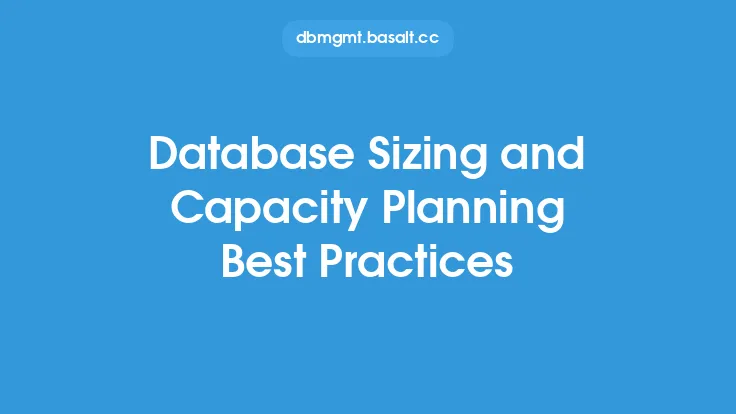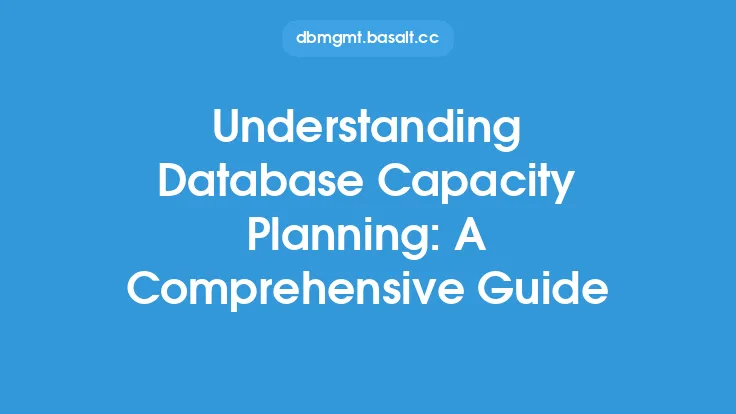When it comes to ensuring the optimal performance and efficiency of a database, two crucial aspects come into play: performance and capacity planning. Database performance refers to the ability of the database to process and respond to queries and requests in a timely and efficient manner, while capacity planning involves anticipating and preparing for future growth and demands on the database. In this article, we will delve into the key considerations for database performance and capacity planning, exploring the technical and strategic aspects that are essential for a well-designed and efficient database.
Introduction to Database Performance
Database performance is a critical factor in determining the overall usability and effectiveness of a database. It encompasses various aspects, including query execution time, transaction throughput, and data retrieval efficiency. To achieve optimal performance, database administrators must consider several key factors, including hardware resources, database configuration, indexing, and query optimization. Hardware resources, such as CPU, memory, and storage, play a significant role in determining database performance. For instance, a database with insufficient memory may experience performance degradation due to frequent disk I/O operations. Similarly, a database with inadequate CPU resources may struggle to execute complex queries efficiently.
Database Capacity Planning Fundamentals
Database capacity planning is the process of anticipating and preparing for future growth and demands on the database. It involves analyzing current usage patterns, forecasting future requirements, and ensuring that the database is adequately provisioned to meet those needs. Effective capacity planning requires a deep understanding of the database's workload, including the types of queries, data volumes, and user activity. By analyzing these factors, database administrators can identify potential bottlenecks and take proactive measures to address them. For example, if a database is experiencing rapid growth in data volume, the administrator may need to upgrade storage capacity or implement data compression techniques to ensure efficient data storage and retrieval.
Key Considerations for Database Performance and Capacity Planning
Several key considerations are essential for effective database performance and capacity planning. These include:
- Hardware Sizing: Ensuring that the database server has sufficient hardware resources, such as CPU, memory, and storage, to handle current and future workloads.
- Database Configuration: Optimizing database configuration parameters, such as buffer pool size, sort area size, and log file size, to achieve optimal performance.
- Indexing and Query Optimization: Implementing efficient indexing strategies and optimizing queries to reduce execution time and improve data retrieval efficiency.
- Data Management: Implementing effective data management practices, such as data compression, data partitioning, and data archiving, to ensure efficient data storage and retrieval.
- Monitoring and Analysis: Continuously monitoring database performance and analyzing workload patterns to identify potential bottlenecks and areas for improvement.
Technical Aspects of Database Performance and Capacity Planning
From a technical perspective, database performance and capacity planning involve several key aspects, including:
- Database Engine: The database engine, such as Oracle, Microsoft SQL Server, or MySQL, plays a significant role in determining database performance. Each database engine has its own strengths and weaknesses, and understanding these characteristics is essential for effective performance and capacity planning.
- Storage Subsystem: The storage subsystem, including disk arrays, storage area networks (SANs), and solid-state drives (SSDs), is critical for database performance. Optimizing storage configuration and ensuring adequate storage capacity are essential for efficient data storage and retrieval.
- Network Infrastructure: The network infrastructure, including network bandwidth, latency, and packet loss, can significantly impact database performance. Ensuring that the network infrastructure is adequately provisioned and configured is essential for optimal database performance.
Best Practices for Database Performance and Capacity Planning
To ensure optimal database performance and capacity planning, several best practices should be followed, including:
- Regular Monitoring and Analysis: Continuously monitoring database performance and analyzing workload patterns to identify potential bottlenecks and areas for improvement.
- Proactive Maintenance: Performing regular maintenance tasks, such as backups, indexing, and statistics gathering, to ensure optimal database performance and prevent downtime.
- Capacity Planning: Anticipating and preparing for future growth and demands on the database, including upgrading hardware resources, optimizing database configuration, and implementing efficient data management practices.
- Testing and Validation: Thoroughly testing and validating database performance and capacity planning strategies to ensure that they meet current and future requirements.
Conclusion
In conclusion, database performance and capacity planning are critical aspects of database design and administration. By understanding the key considerations, technical aspects, and best practices for database performance and capacity planning, database administrators can ensure optimal database performance, efficiency, and scalability. Effective database performance and capacity planning require a deep understanding of the database's workload, hardware resources, and configuration parameters, as well as a proactive approach to monitoring, analysis, and maintenance. By following these principles and best practices, organizations can ensure that their databases are well-designed, efficient, and capable of meeting current and future demands.





